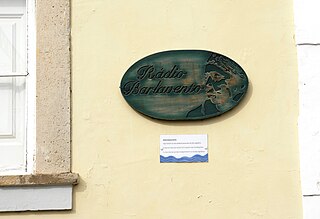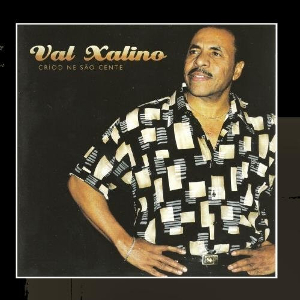| Part of a series on the |
| Culture of Cape Verde |
|---|
 |
| History |
| People |
| Languages |
| Cuisine |
| Religion |
| Literature |
| Music |
| Sport |
Mass media in Cape Verde includes aspects of telecommunications, television and radio.
| Part of a series on the |
| Culture of Cape Verde |
|---|
 |
| History |
| People |
| Languages |
| Cuisine |
| Religion |
| Literature |
| Music |
| Sport |
Mass media in Cape Verde includes aspects of telecommunications, television and radio.
In 2011, there were approximately 73,000 main line telephones and 500,000 mobile and cellular phones in use in Cape Verde, cellular phones was nearly one per person.
There are three television stations in Cape Verde, one state owned (RTC - TCV) [1] and three foreign owned, RTI Cabo Verde launched by the Portuguese-based RTI in 2005, on March 31, 2007, Record Cabo Verde, its own version was launched by the Brazilian-based Rede Record. [2] and TIVER. Cape Verde has now received TV CPLP and some of its programs are broadcast, the network first aired in 2016. Premium channels includes the Capeverdean versions of Boom TV and Zap Cabo Verde, two channels owned by Brazil's Record. [3] Other premium channels are aired in Cape Verde especially on satellite networks, they are common in hotels and villas but availability is predominantly limited, one of them is RDP África, the African version of the Portuguese radio station RDP.
The media is operated by the Capeverdean News Agency (secondarily as Inforpress).
Nationwide radio stations include RCV, RCV+, Radio Kriola, the religious station Radio Nova. [1] Local radio stations include Rádio Praia, the first radio station in Cape Verde, Praia FM, [1] the first FM station in the nation, Rádio Voz de Ponta d'Água of North Praia and Radio Morabeza in Mindelo.
Radio stations formerly existed included and Rádio Clube do Mindelo which later became Rádio Barlavento which existed until 1975, it was later replaced with Rádio Voz de São Vicente and became part of RCV.
Internet providers and search providers in Cape Verde include SAPO CV and recently Google.

Horizonte is a daily newspaper. The government-run Novo Jornal-Cabo Verde is published twice weekly. Weekly periodicals include A Semana , [1] Expresso das Ilhas , [1] Jornal Horizonte , Terra Nova , Boletim Informativo , A Nação , founded in 2007 and A Voz founded in 2013. Today, many of these national level newspaper sites are also available online (some with subscription). Regional newspapers includes Jornal O Cidadão (São Vicente), Artiletra (São Vicente), a bi-monthly newspaper/periodical, Jornal de São Nicolau and Oceanpress (Sal). Newspapers are written in the official language, Portuguese. Some such as A Semana and Jornal Horizonte has some articles written in Cape Verdean Creole. Newspapers, especially online are also written in English, some newsstands offers English language papers and rarely French especially at touristic areas of the islands of Sal and Boa Vista. The first English language papers were first written in the late-19th century but were rarely common, most of them were available in Mindelo, São Vicente which were one of the most coal refueling stopovers in West Africa. Online, recently some articles on A Semana is also available in English.
There are also online national level newspapers and news sources, sports-oriented news sources available includes Criolosport and recently Sports Mídia.
Others including the airline magazine of TACV Fragata.
In the colonial area, there was a journal that was like a newspaper, the first was Boletim Oficial de Cabo Verde (Official Bulletin of Cape Verde) which first published on 24 August 1842 on the island of Boa Vista. Second came Independente on 1 October 1877 in Praia, Santiago, third came O Correio de Cabo Verde (Cape Verde Post) on 19 April 1879 and fourth came Echo de Cabo Verde (Echo of Cape Verde, Modern Portuguese: Eco de Cabo Verde) first published in April 1880. Mindelo made journals included Revista de Cabo Verde and Liberdade, both started in 1889.
In Praia, there were journals including O Povo Praiense, first made on 13 July 1886, O Praiense made in 1889 and later Praia made in the same year.
One of the recent was named Notícias de Cabo Verde (News from Cape Verde) and Jornal de Cabo Verde (Cape Verde Journal) during the mid 20th century, started publishing in 1931 and the newer O Eco de Cabo Verde (Echo of Cape Verde).
The Constitution of Cape Verde provides for free expression, and the government is said to uphold this right generally. Government authorization is not needed to establish newspapers, other printed publications, or electronic media.
One media based abroad is VozDiPovo-Online , an online newspaper founded in 2004 and is based in Aveiro, Portugal and serves the Capeverdean community there.

Cape Verde is known internationally for morna, a form of folk music usually sung in the Cape Verdean Creole, accompanied by clarinet, violin, guitar and cavaquinho. Funaná, Coladeira, Batuque and Cabo love are other musical forms.

The Cape Verdean Football Federation is the governing body of football in Cape Verde. It was founded in 1982, affiliated to FIFA in 1986 and to CAF in 2000. It organizes the national football league and the national team.
Jornal Horizonte or O Horizonte is a weekly Cape Verdean newspaper that covers the top stories in the archipelago and local stories from each island. Expresso das Ilhas is located in the Cape Verdean capital city of Praia and is one of the most circulated newspapers and dailies in Cape Verde..

Cesária Évora Airport is Cape Verde's fourth-busiest airport, located on the island of São Vicente, nearly 5 kilometres (3.1 mi) from the centre of Mindelo. It is located in the valley area in the west of the island and is north of the village of São Pedro. Its runway is 2,000 metres (6,600 ft) long and its width is 45 metres (148 ft)

The Radiotelevisão Caboverdiana is Cape Verde's first radio and television station broadcasting local programs from Cape Verde, Portugal and Brazil as well as the rest of the world especially France. It is a publicly owned company and enterprise and is located in the Capeverdean capital city of Praia, in the southern part in the middle of Achada Santo António RTC also has a few buildings, it also has offices in São Vicente, Sal, São Filipe on Fogo Island and Assomada in Santa Catarina. The building size is very small. The radio building is in the south on Rua 13 de Janeiro and the television station is in the north. Its current president is José Emanuel Tavares Moreira.

Arménio Adroaldo Vieira e Silva is a Cape Verdean writer, poet and journalist. He began his activity during the 1960s, collaborated in SELÓ, Boletim de Cabo Verde, Vértice (Coimbra) review, Raízes, Ponto & Vírgula, Fragmentos, Sopinha de Alfabeto and others.

Rádio Barlavento was a radio station in Cape Verde which broadcast in the Portuguese language from 1955 until 1974. It was a shortwave (CR4AC) station broadcasting on 3930 kHz. From 1947 until 1955 it was called Rádio Clube do Mindelo. In 1974 it was seized by members of the Partido Africano da Independência de Guiné-Bissau e Cabo Verde - PAIGC, who sought to "get the station out of hands of those who aligned with colonial power." After this the station became Rádio Voz de São Vicente. The station served the entire Barlavento island group including Santo Antão, São Vicente, São Nicolau, Sal and Boa Vista. The station was located in a building near downtown Mindelo, which is now the Centro Nacional de Artesanato e Design, and broadcast Cape Verdean traditional music, local programs, and Portuguese and some international programming. Rádio Voz de São Vicente later became an affiliate of RCV, Mindelo's own station would have another separate one and would be named Rá
The Alfabeto Unificado para a Escrita do Caboverdiano, commonly known as ALUPEC, is the alphabet that was officially recognized by the Cape Verdean government to write Cape Verdean Creole.
José Gabriel Lopes da Silva, also known as Gabriel Mariano, was a Cape Verdean poet, novelist, and an essayist.
Vasco Martins is a Cape Verdean musician and composer. Born in Queluz, Portugal, in 1956, he lives now in Calhau, Cape Verde.

Cape Verde or Cabo Verde, officially the Republic of Cabo Verde, is an archipelago and island country of West Africa in the central Atlantic Ocean, consisting of ten volcanic islands with a combined land area of about 4,033 square kilometres (1,557 sq mi). These islands lie between 600 and 850 kilometres west of Cap-Vert, the westernmost point of continental Africa. The Cape Verde islands form part of the Macaronesia ecoregion, along with the Azores, the Canary Islands, Madeira and the Savage Isles.

The history of the cinema of Cape Verde dates back to the arrival of filmmakers in the early twentieth century. The first picture house was established in Mindelo around 1922, called Eden Park.
Basketball is the second most popular sport in Cape Verde. The league are divided into eleven divisions, Santiago and Santo Antão has two zones since the early 2000s. The basketball association is a federation which is known as the Capeverdean Basketball Federation. The FCBB was founded in 1986 and became affiliated to FIBA in 1988.
Record Cabo Verde is a channel of Record in Cape Verde. It is the first Brazilian based channel to have its own version in Cape Verde. The network was launched on 31 March 2007.
Elisângelo Ramos is a Cape Verdean journalist who has been at RTC since 1997, having worked in the broadcasting, television and the press sectors. He is a reporter for RCV in the city of Praia and is a producer of cultural programs.

The Literature of Cape Verde is among the most important in West Africa. It is the second richest in West Africa after Mali and modern-day Mauritania. It is also the richest in the Lusophone portion of Africa. Most works are written in Portuguese, but there are also works in Capeveredean Creole, French, and notably English.
The Culture of the Island of São Vicente, Cape Verde is the second richest in the nation, with a range of customs and practices common in the islands,
The 2018 Cape Verdean Football Championship season is the 39th beginner level competition of the first-tier football in Cape Verde. Also it was another season that it was sponsored by a clothing company Tecnicil, it was also known as the 2018 Cape Verdean Tecnicil football season or the 2018 Tecnicil Football Championships. The championship was governed by the Cape Verdean Football Federation. The season began earlier started on 7 April 2018 and finished on 2 June.

Criod de São Cente is a 2011 album by Val and Roberto Xalino. The songs were written by Val Xalino's son Roberto. The album includes the new single "Praía de Baia", one of Cape Verde's greatest ballads, released on Val Xalino's first album Dança Dança T' Manchê in 1987. Some singles features both Val and Roberto Xalino. The album also features music by Val and Roberto Xalino, Djo d'Eloy, Manuel de Novas and Luis Silva. Four singles from the record were nominated in the 2011 Cabo Verde Music Awards
Annotated directory